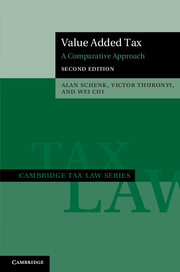Book contents
- Frontmatter
- Dedication
- Contents
- List of Tables and Charts
- List of Cases
- Preface to the Second Edition
- 1 Introduction
- 2 Consumption Tax Forms and Base Alterations
- 3 Varieties of VAT in Use
- 4 Registration, Taxpayer, and Taxable Activity
- 5 Taxable Supplies and Tax Invoices
- 6 The Tax Credit Mechanism
- 7 Introduction to Cross-Border Aspects of VAT
- 8 Timing and Valuation Rules
- 9 Zero-Rating, Exemptions, and Exempt Entities
- 10 VAT Evasion and Avoidance
- 11 Gambling and Financial Services (Other than Insurance)
- 12 Insurance
- 13 Real Property
- 14 An Anatomy of the Chinese VAT
- 15 Interjurisdictional Aspects
- Appendix VATs Worldwide
- Index
- References
14 - An Anatomy of the Chinese VAT
Published online by Cambridge University Press: 05 February 2015
- Frontmatter
- Dedication
- Contents
- List of Tables and Charts
- List of Cases
- Preface to the Second Edition
- 1 Introduction
- 2 Consumption Tax Forms and Base Alterations
- 3 Varieties of VAT in Use
- 4 Registration, Taxpayer, and Taxable Activity
- 5 Taxable Supplies and Tax Invoices
- 6 The Tax Credit Mechanism
- 7 Introduction to Cross-Border Aspects of VAT
- 8 Timing and Valuation Rules
- 9 Zero-Rating, Exemptions, and Exempt Entities
- 10 VAT Evasion and Avoidance
- 11 Gambling and Financial Services (Other than Insurance)
- 12 Insurance
- 13 Real Property
- 14 An Anatomy of the Chinese VAT
- 15 Interjurisdictional Aspects
- Appendix VATs Worldwide
- Index
- References
Summary
Introduction
In 2013, the VAT in China yielded approximately the equivalent of USD 500 billion for the government, making it very likely the largest VAT in the world in terms of the dollar value of revenue generated. It is, however, not normally regarded as a paragon of VAT design and is perceived not only by international experts but also by Chinese tax policymakers and commentators themselves to be inferior to the VAT regimes adopted in advanced economies. The Chinese government has continuously attempted to “improve” its VAT in the last two decades, sometimes in part (but only in part) to make it conform more to common international practice. In this chapter, we present select aspects of the Chinese VAT, giving special emphasis to those features of it that contradict the normal recommendations for VAT design. We do this for three interrelated reasons.
The first is that many developing and middle-income countries and many transitional economies heavily rely on the VAT for revenue generation. Many of them have “imperfect” VAT systems relative to policies recommended by standard public finance theory and practices adopted in developed countries. However, from a comparative perspective, these systems (especially those found in large countries like China, India, and Brazil) are important in an obvious sense: they shape the understandings of large populations of taxpayers, tax professionals, and tax administrators about what the VAT is. For example, as discussed in this chapter, Chinese VAT taxpayers and tax administrators are accustomed to the fact that no refund for excess input credit will ever be given for domestic supplies. (The difficulty of issuing VAT refunds will resonate as a critical issue for those dealing with VATs in many, if not most, developing countries.) They also seem content with the absence of the concept of economic or business activity, supposedly central to the VAT laws of other countries. Relative to conventional portrayals of the VAT, these and other features of the Chinese VAT look quite unusual. However, it is useful for our comparative study to reflect some of this diversity of VAT law and design. Moreover, we may conclude, after careful analysis, that some of the supposedly “inferior” features of an impure VAT do not make enough of a difference in practice.
- Type
- Chapter
- Information
- Value Added TaxA Comparative Approach, pp. 441 - 486Publisher: Cambridge University PressPrint publication year: 2015

